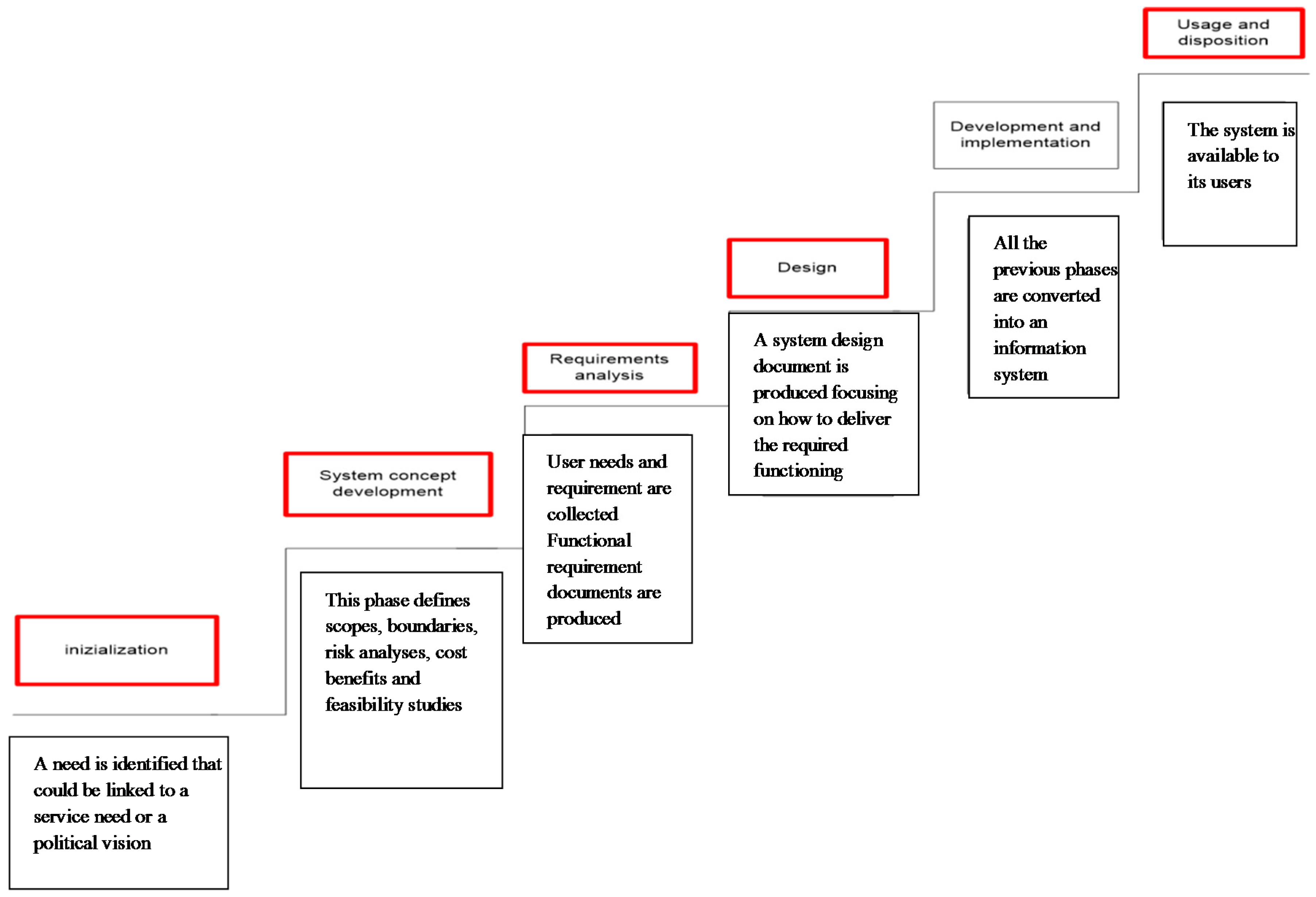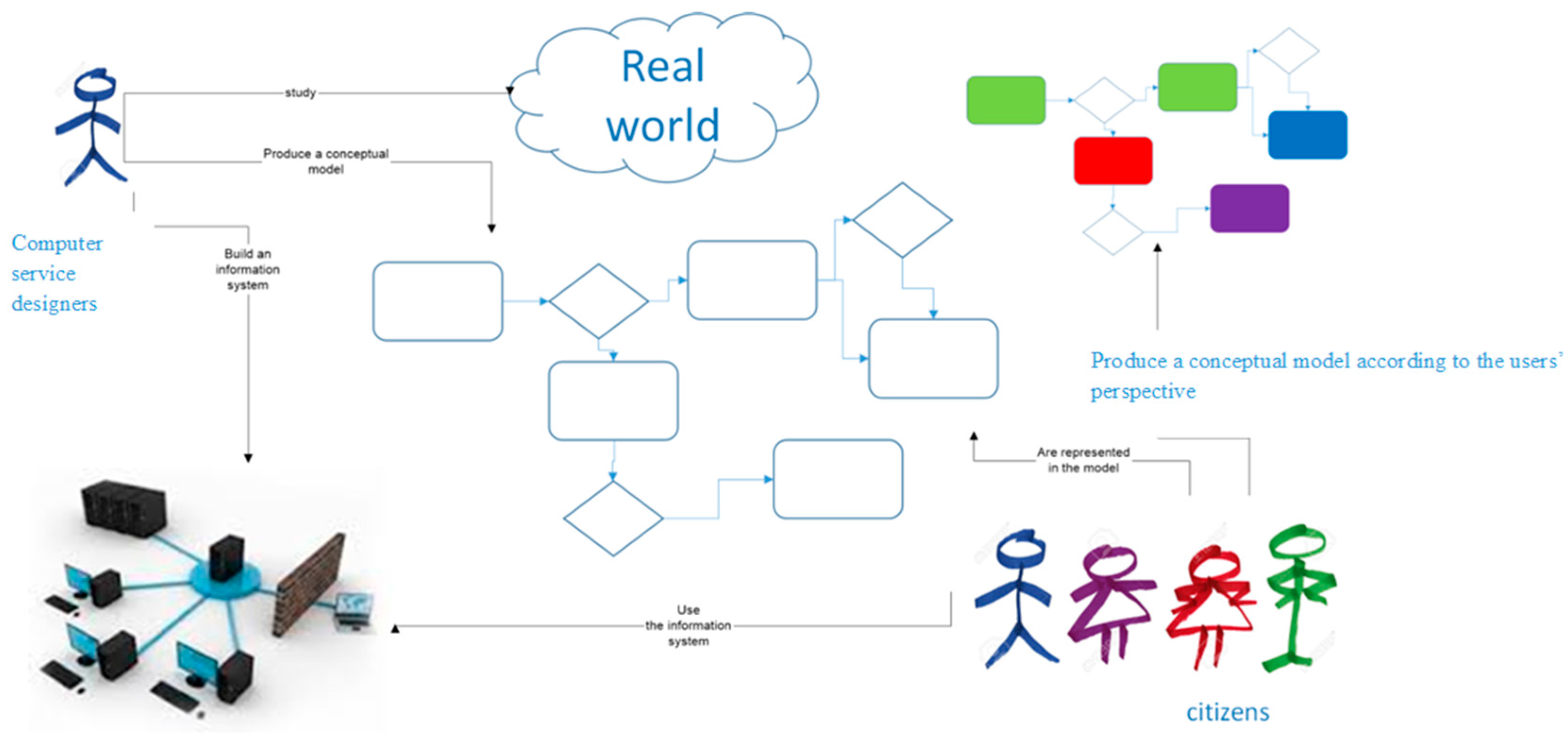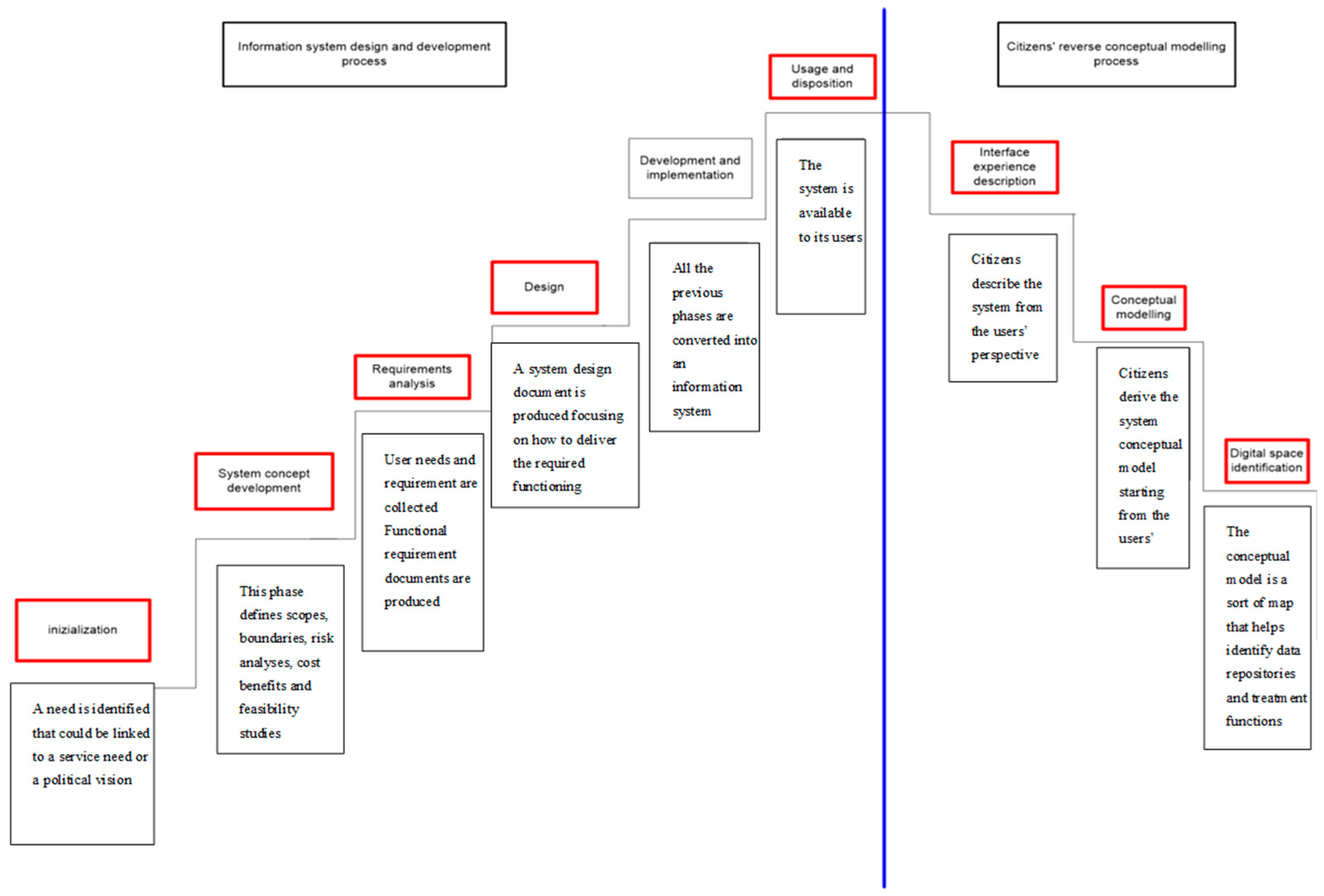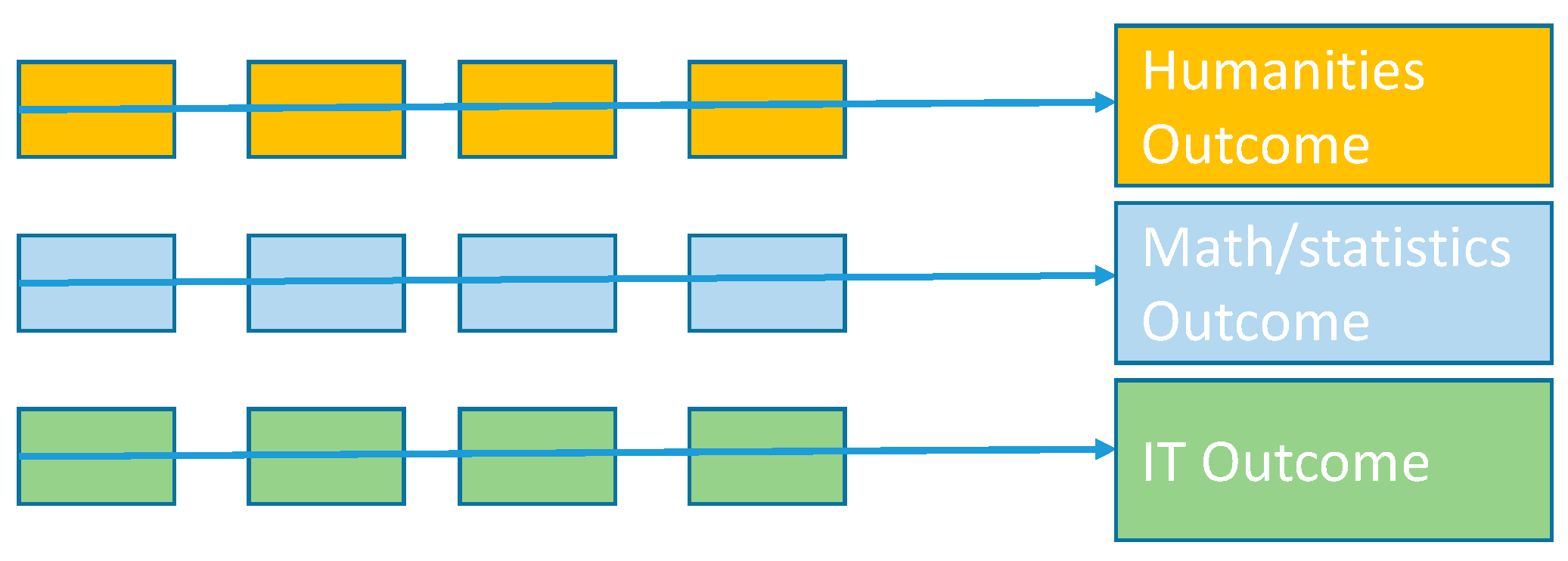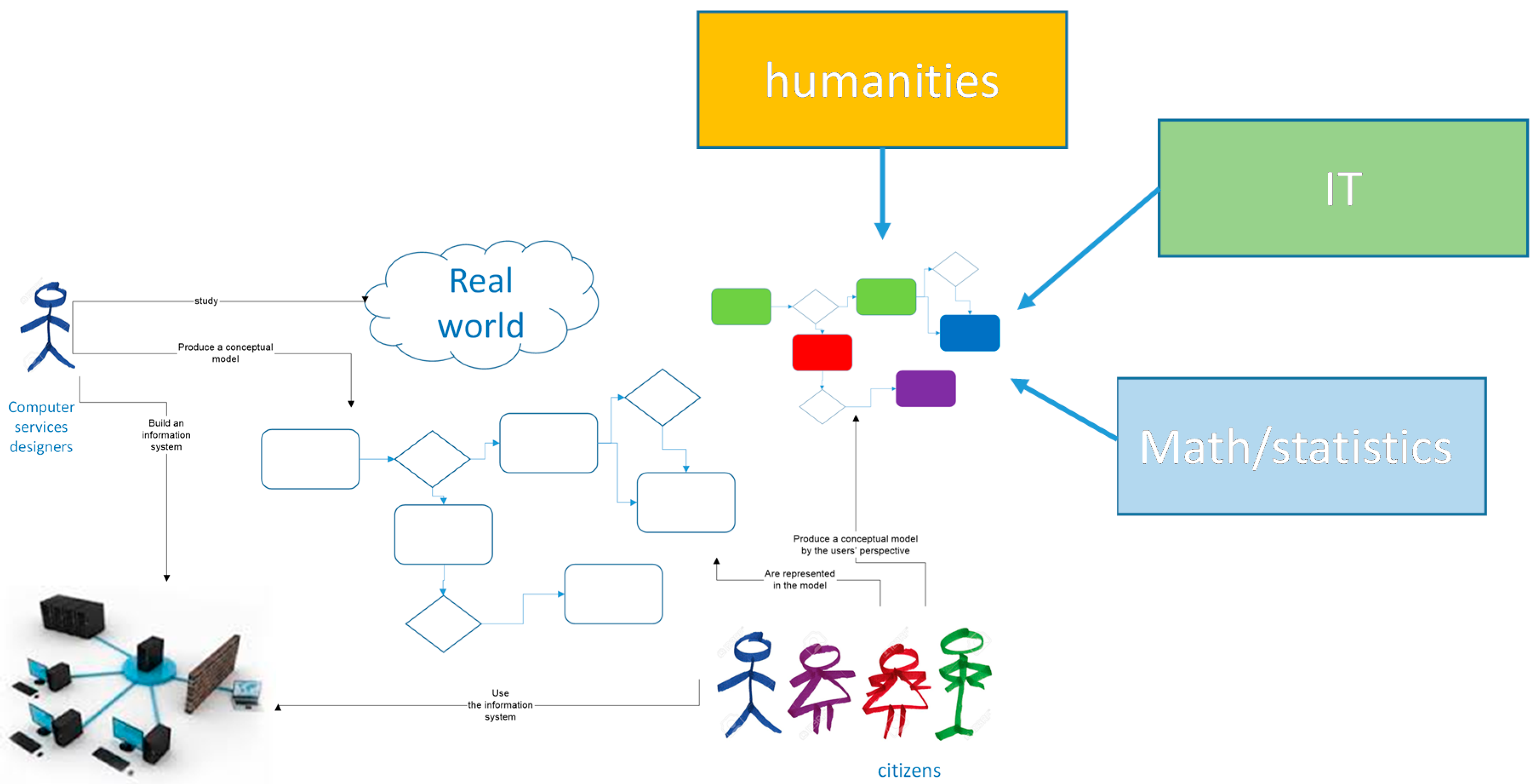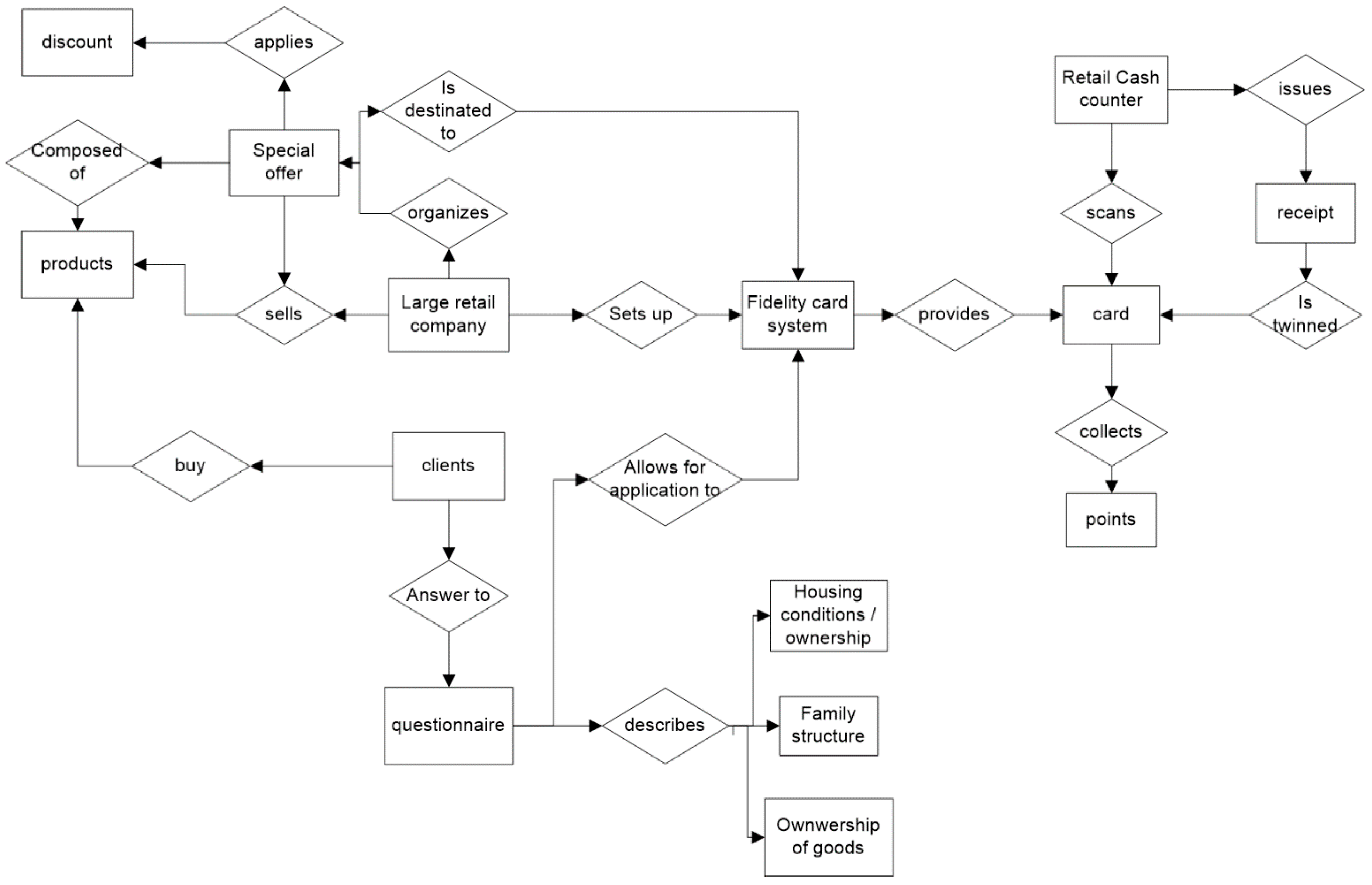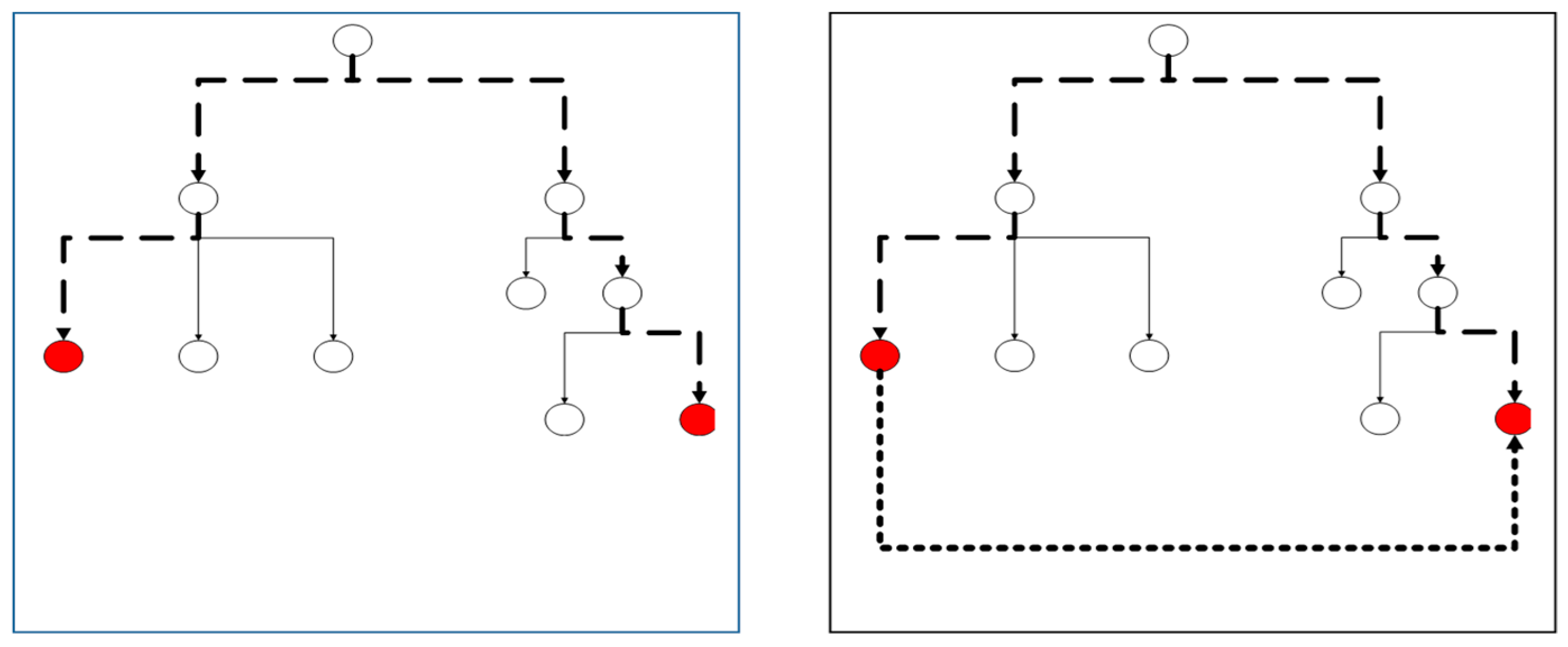1. Introduction
New technologies have a huge impact on social life [
1,
2], changing (i) the quality of personal relationships [
3,
4]; (ii) the concept of proximity [
5]; (iii) the idea of authority; (iv) privacy; (v)liberty; (vi) economy [
6]; and (vii) democracy.
Many authors have reflected on the impact of new technologies on personal lives and on the concept of being a citizen: as new technologies are always information-rooted, considerations have been made in terms of the right of being skilled enough to cope with modernity [
7,
8] and on the respect of rights in the digital society.
The role of smart technologies in social participation [
9,
10,
11] has also been widely explored and discussed, as well as how they improve and empower citizens’ initiative, proactivity, and involvement efforts.
The aim of this paper is to address the issue of “being an active and conscious citizen” (in all the accepted meanings of this expression) from a different perspective. Information technologies use and create data spaces: a plurality of repositories and databases keep citizens’ memories, creating a sort of digital territory that any modern citizen is obliged to inhabit. Among traditional citizenship dimensions, new rights, linked to these new digital territories, have to be granted: awareness of potential dangers is the main element to achieve, as citizens usually fail to recognize the smart service costs, mainly focused on privacy and freedom.
The underlying idea is that citizens cannot be fully integrated into a modern society without a clear image of their position and role in digital spaces. In this sense, when asking or using smart services and intelligent territories, citizens ought to be aware (i) of the processes (mainly informative and induced by the services they use) involving communities and individuals; and (ii) of their real body boundaries in this unprecedented information territory. The effects of the presence of a person in digital territories may, in fact, deeply impact their lives, relationships and personal security.
The deep gap existing between stakeholders’ languages may hamper these goals. Technicians in charge of the design and construction of smart infrastructure and services are (and often are pleased to be) beyond the comprehension of other citizens: a consequence is that an increasing component of common experiences is outside the citizens’ control, vigilance, and awareness. In this work, we advance the idea that natural language, when linked to technology basics, may be a powerful instrument for achieving social consciousness and broad recognition of technology costs and benefits. This point is hardly surprising as linguistic competency is traditionally a core capability for full citizenship [
12,
13]: in this paper, this idea is developed and updated for the smart citizens’ benefit.
In this perspective, an original educational proposal is advanced and some experiences discussed. The aim is to achieve a methodology, based on conceptual modeling, for addressing new citizenship issues, adopting different and converging perspectives: narrations, data, IT, and measures. The final goal is to induce in young students (and in their teachers) the idea that, in order to be an active citizen in modern society, all of these skills must act together, sharing a common language [
14].
The paper is organized as follows: after a brief focus on the complexity paradigm, the concept of multidimensional citizenship in a knowledge space is discussed. With this in mind, the paper analyses the strategic role of natural language and conceptual modeling and presents some applications and lesson examples.
2. Education to Complexity
What do we mean by smart citizenship [
15]? Is it about enjoying smart territory benefits or demanding innovative services? Does it concern drawbacks and dangers for freedom and privacy [
16]? In all cases it involves being skilled enough to cope with modernity and new social instruments: education to complexity is paramount.
In a traditional context, citizens are usually able to recognize their position in a hierarchy (social or economic) and in a community. Nowadays, the challenge is to recognize this position in a network, as a node connected through a plurality of relations and processes, feedbacks and back interactions.
Before reflecting on what being a citizen in a complex context means, it is worth focusing on complexity and its consequences in social life.
According to Barabási conceptualization and language [
17], a complex network is not just a matter of interconnected agents: complex systems display several organizing principles, which are, at some levels, encoded in their topology.
2.1. Small World
Small world propriety means that, despite their size, in most networks there is a relatively short path between any two nodes. The distance between two nodes is defined as the number of edges along the shortest connecting path: the most popular
small world expression [
18] is the “six degrees of separation” concept, proposed in 1967 by the social psychologist Stanley Milgram.
Small world property has inspired sociologists and politicians and it has often been declined in terms of interdependency and multiculturalism: in this paper, we would like to re-think it in terms of the citizens’ right to short distances to services and information. Communities are nowadays experiencing an unprecedented situation: they are inside a highly interconnected external environment, even if the governance rules are still grounded on authority and accountability principles, often organized in terms of hierarchies. The gap between the hierarchy of responsibilities and the network of information is difficult to understand and accept.
The complexity of modern citizenship challenges calls for an original tradeoff between the capacity to exert full authority and power (through hierarchies) and the acknowledgement that only a network system of competencies, vigilance, and trust can assure transparency and democracy.
2.2. Clustering
A common property of complex networks is an inherent tendency to clustering, quantified by the clustering coefficient [
19]: in most real networks, the clustering coefficient is typically much larger than it is in a random network of an equal number of nodes and edges.
Social networks provide practical evidence of this point. It is worth considering how clustering occurrences often happen without the cluster participants’ knowledge: this is the case of those driven by marketing, political, or consensus reasons.
2.3. Degree Distribution
Not all nodes in a network have the same number of edges. Usually in a random graph, as the edges are placed randomly, the majority of nodes have approximately the same degree and their distribution
P(
k), which gives rise to the probability that a randomly selected node has exactly
k edges, is a Poisson distribution. Empirical results show that for complex networks, the degree distribution significantly deviates from a Poisson distribution. Such networks are called scale-free [
20]. A scale-free network originates when a node, having to establish a new association, prefers to link itself with a node already characterized by many connections, contributing to an exponential growth of its connections inside the network: in this way the functional form of
P(
k) deviates from the Poisson distribution of
P(
k) expected for a random graph.
A social consequence is that complex networks, also thanks to innovative technologies, indicate new leadership modalities sometimes outside the citizens’ awareness or control.
3. Being a Citizen in a Smart and Complex Environment
Complex networks have strong implications in many domains, and there are many cases in which recognizing a system as such (from information, to epidemiology, to social systems, to communities) allows for having a deeper insight into its properties, potentialities, and behaviors [
21], empowering, in this way, citizens’ awareness. Adopting a network and complexity perspective for reflecting on citizenship may provide new insights in modern societies.
Citizenship has been one main narrative in describing construction strategies of political and social arrangements in modern societies [
22]: complexity may have a deep impact on this.
After the 1949 Marshall’s Cambridge Lecture [
23], citizenship has been theorized not only as a legal and political status, but also as a social status [
24], thus gaining a multidimensional character: the expansion of individual and collective rights, in fact, is traditionally attached to the status of citizen.
In modern societies, the process of rights claiming, which is a traditional active citizenship expression, is usually mediated by IT systems. Citizens ask for efficiency, accessibility, and performance; they demand an evolutive environment, able to recover from errors and disservices, oriented to ever-growing service provisions.
In smart communities, therefore, persons have a two-fold citizenship experience: on one side, the level of their rights recognition is satisfied as never before, on the other, services in support of rights compliance, being IT mediated, generate complex data networks, the digital territories previously outlined. The concepts of community and citizenship are deeply involved and changed: traditionally, a community has been modeled as a political or institutional unit, a set of personal and empirical relationships, or on the basis of the geographical spaces where lives happen. Nowadays a community is also a linguistic object, in which every citizen is both author and content of different narrations. When integrated together, they form the overall information system [
25,
26,
27], which, according to the complexity paradigm previously discussed, could be extraordinarily more informative than the sum of its components.
The modern communities and citizenship dimensions previously outlined, fit very well with the smart city concept: despite the fact that the term “smart city” has become more and more widespread, its sense, definition and dimensions are not always clear [
28,
29]. As any city may be conceived in terms of relations and territories [
30], in this paper smart city will be conceptualized as a particular context, capable of learning from feedbacks and reacting to its inhabitants needs: a territory in which information is used to shape relations useful for adapting services to its stakeholders’ exigencies and rights.
Following the complex paradigm outlined above, we can see how smartness falls within this frame.
Being highly connected environments, smart cities present a network structure in which the encoded topological properties previously discussed are usually true: at what level is a citizen aware of being in a small world? Is he/she aware of the existence of a plurality of path to reach targets, information, institutions? Are citizens conscious of the existence of hubs? What kind of legitimacy do they have? In accordance with which process does a network edge become a hub?
In this perspective, the educational proposal for smart citizenship will be advanced and discussed [
31].
3.1. Natural Language and Conceptual Modeling in Support of Citizenship
As previously outlined, it is widely acknowledged that living in a complex environment may provide advantages and potentialities. A question arises: are citizens also able to recognize and evaluate risks and costs connected to the services they are asking for?
Usually communities find a trade-off between benefits and costs linked to rights acknowledgment: for instance, in traditional social debates, there may be conflict about the costs of services delivery and their distribution. Nowadays we also have to take into account those linked to proper and legitimate management of the complex digital spaces generated by the acknowledged services. The risks associated with abuse are also to be considered.
A smart citizen, aware of being an element of a more general narration, must be provided with skills and instruments to shape digital spaces according to their visions, projects, rights protection.
As with any citizenship dimension, this awareness has to be granted to everyone, regardless of personal technical skills: in this paper, natural language and conceptualizations are the required competences: we are dealing with non-technical assets widely used by IT professionals to model and build smart services. The challenge is to also restore them to unskilled citizens in order to empower them and allow them to verify and discuss potential smart service risks for individuals and communities.
3.1.1. Natural Language
The first tool in support of smart citizenship is natural language: its role in information system design and construction is known and is related to careful and active listening to the users’ needs and requirements.
It is not surprising that narrations are so strategic in both developing and using an information system: Jerome Bruner [
32], for instance, has argued that one of the ways in which people understand their world is through the “narrative mode” of thought, which is concerned with human wants, needs, and goals.
In formal information system development, the production and collection of narrations and storytelling corresponds to the part of the design process in which the users’ needs and requirements (along with their service vision) are collected and analyzed. It is worth noticing that this aspect in information system development is closer to traditional active citizenship: it concerns speaking about needs and the contexts and conditions for meeting them.
Information systems are usually developed in line with the methodology sketched in the following image: the boxes with red borders have, to a certain extent, been developed in natural language and, if properly arranged, they may even be up to non-skilled citizens.
Speaking of public services, for example, initialization could be a political phase in which citizen involvement is usually very high. System design may include dominion-experts: media and public opinion may demand information feedback. The figure shows that due to language and technical barriers, development and implementation are the only processes totally outside the citizens’ comprehension.
3.1.2. Conceptual Models
The second tool is conceptual modeling. Any information system [
33,
34] is based on its conceptual model, produced on the basis of collected narrations and stakeholders’ requirements.
The role of conceptual modeling in information system development is widely known: the value of conceptual models lies in their ability to capture the relevant knowledge about a domain, facilitating the engagement of involved stakeholders and supporting the reciprocal comprehension of users and designers.
Any real world narration is often translatable in a conceptual model, describing the semantics of the organization and representing assertions about its nature. Relations between ideas, images, or words are represented as well. Conceptual models may have a graphical representation, a map, in which concepts are usually enclosed in circles or boxes, and connecting lines between two concepts specify their relationships.
Conceptual models do not have any IT implications and support mutual comprehension between different languages and technical cultures: in other words, they cannot be considered a merely technological phase (even if they are compulsory in any information system design), as they are linked with the capability of properly describing and defining a problematic area.
The passage from narrations to conceptual models may be performed at different formality levels: in the educational experiences described and discussed in this paper the one closest to the natural language level has been chosen.
System designers use different modeling methodologies for (i) data (entity relationships, object oriented); (ii) processes (Idef0, FRAM); and (iii) interfaces (UML use cases). These approaches are all non-technical and natural language-based, and they are intended to bridge the gap between dominion experts and system developers.
It is always possible to harmonize these models: in the educational proposal, for instance, starting from a description of reality under the user services perspective, we intend to induce knowledge on the data system and on the processes, which generate and use these data.
3.2. Natural Language, Conceptual Models, and Data Spaces: A Bridge between System Users and Providers
In this paper, we advance the proposal that when a citizen, using the natural language, is able to recognize a service conceptual model, he/she is also capable of identifying databases, information repositories, informative potentialities as well as linking conditions with other sources: in this way, the digital territory created by the services used begins to take shape.
In this methodological proposal, conceptual models are adopted as an instrument per se, for their explanatory potentialities and their ability to orient unskilled citizens in digital territories. In this perspective, the adopted methodology relies on the use of conceptual mappings [
35,
36] as a support for education [
37,
38] to improve a meaningful understanding of the materials studied.
In this approach, concept maps met the need to explicitly show how new concepts and propositions were integrated into the learner’s cognitive structure, helping students learn how to learn, capture explicit and tacit knowledge held by experts, assist in the design of instruction, facilitate creative work in every discipline, and facilitate improvement of management and marketing methods.
This proposal actualizes a pioneering use of conceptual mappings [
39] and, in this perspective, it does not use conceptual models towards any form of operationalization, but only as an asset in support of comprehension and learning. An original methodological update to this consolidated educational perspective, is given by the fact that, in this case, conceptual modeling is specifically addressed to reconstruct and understand an IT service structure by its users’ view, with the explicit objective of also learning about the potentialities and risks for privacy, freedom and full active citizenship expression.
A potential drawback is given by the fact that, usually, IT service conceptual models are not available for their users, who only approach them through their interfaces. In approach of this paper, we advance the proposal that this informative gap is bridged using the users’ experiences and views developed in natural language as a source for a reverse conceptual modeling.
Citizens require services: their requests, expressed in natural language, are the basis for the new system structure and architecture. When constructed, citizens use the system and obtain the services requested without knowing how it has been built.
They are, in any case, able to describe the delivered services and what the system does: anyone is able to describe the experience of paying with a credit card, using an app to get a service, passing in a video-surveilled street. On the bases of these narrations, it is possible to derive and re-model a system conceptual model draft, useful for the citizens, to gain a clearer view of the digital space created by the services they use.
Moving from interfaces to system architecture and code is not an original approach and it is a classic example of reverse engineering. Citizenship empowerment does not need this technical specification level: it could be enough to broadly recognize the model on which the system architecture is based in its most abstract and general form.
Neither is the idea of using natural language to understand complex organization new [
40]; it has quite a long tradition starting from problems of strategic management in complex environments. With respect to these early applications, technology has made important advances, even if the basic approach is still very similar: natural language is a useful modeling tool as it is rich enough to cope with the complexity of organizations.
To support these points, the following picture illustrates a very common situation: an institution wants to provide services to support a problematic area. In this perspective, information systems designers and producers build a problem/solution conceptual model, on the basis of which they create the system.
Citizens, as system users, are represented in the model: to provide the services, their data may be collected and integrated with other sources. They use the system through dedicated interfaces and often interfaces are their only perspective; the picture shows how a simplified system conceptual model draft may be derived from the users’ point of view.
The users’ conceptual model will not necessarily be the same as the one developed by system designers. It will be less detailed and the result of the joint efforts of different users profiles (illustrated in the picture with different colors), but it will still provide a deeper insight into the system’s informative structure. Citizens will be more skilled in recognizing the data territory generated by their service usage.
The chart discussed and presented in
Figure 1 has now been completed with the reverse modeling actions performed by citizens.
The following
Table 1 summarizes the citizens’ role in the different phases of an IT service development.
They are not condemned to transfer their sovereignty to technology: the
Table 1 shows all the phases in which they could be actively involved.
Citizens (
Figure 2) have several cards to play in order to achieve control and transparency, even in smart and intelligent communities, from the very beginning of the IT processes when they may claim participation in new service modeling, to the usage phase (
Figure 3) in which they must be more skilled and conscious in order to be vigilant and critical of the effective costs of smart services.
5. Final Remarks
The ever-growing demand for specialized smart services may have potentially dangerous side effects on freedom, privacy and, ultimately, on the concept itself of citizenship and democracy: with respect to this unprecedented situation there is a lack of awareness and knowledge that the education system ought to address, providing cultural assets, and empowering methods and attitudes.
Not an easy challenge, as it involves competencies and skills, which are often narrow and deal only with single issues: humanities, IT, math, and statistics teachers could stimulate and inform their students. However, if citizens are required to adapt to complexity, educational systems have to overcome the lack of communication between subjects and disciplines. The objective is to identify a common ground to which every educational stakeholder contributes with specific languages and competencies for overall comprehension.
This paper advances an educational proposal rooted on conceptual models of the users’ experience, which are presented and taught not as the imperative prerequisite for information system operationalization, but as a general and non-technical skill to allow citizens to recognize, discuss and evaluate smart service informative structures.
In this perspective, conceptual models go beyond the IT area and become a crosscutting subject that bridges the gap between languages, sectors and disciplines, supporting the co-working of teachers of different disciplines.
Several examples of lessons are presented and discussed in this paper. The lectures were proposed to classes differing in age and level: the didactic methodology remained the same and was adapted to the students’ age and profile with deeper reflections and insights.
In all the situations experienced, the students were able to formulate original ideas and reflections on the potential costs of the citizens’ right to avail of smart and intelligent services, using the conceptual models produced as a map to be explored, such as unwanted connections with data sources outside the analyzed smart service, for instance.
Beyond the promising results achieved, a major critical factor may be attributed to the teachers’ specific sensibility and preparation on the topic: for this reason, the didactical proposals have to be formulated in a two-step structure: an action addressing educators (together with proper supporting material) and a specific step targeting the students.
It is a complex educational goal: the successfully perceived outcomes of such heuristic experiences indicate further improvement and development directions and motivate us to work out a systematic approach for application of the proposed education guidelines, as well as for its effective evaluation and validation.
